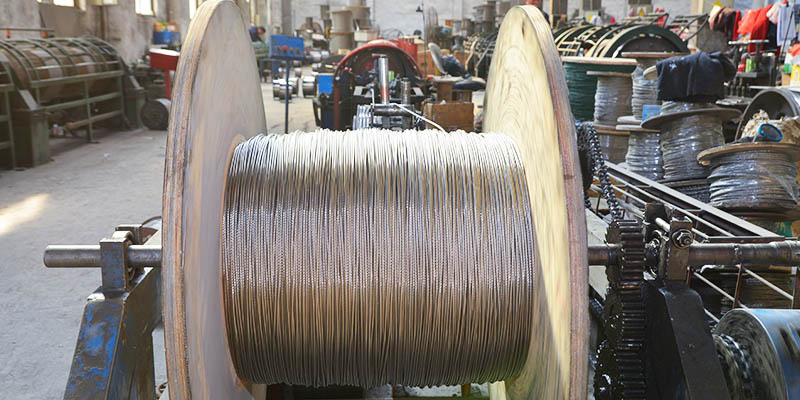1×7 Stainless Steel Wire Rope Product Introduction Overview: The 1×7 stainless steel wire rope is a high-quality, durable, and versatile wire rope constructed from a single strand of seven individual ...
See DetailsFasteners remain essential components in modern industrial manufacturing, construction, transportation, and even aerospace technology. Among the many fastener materials available, stainless steel bolts, due to their excellent corrosion resistance, stable strength, and wide applicability, are one of the most widely used high-performance connection elements on the market. With industrial upgrades and advancements in precision production, the technical content and application depth of stainless steel bolts are continuously increasing, making them a crucial pillar supporting industrial modernization.
Material Structure and Performance Core of Stainless Steel Bolts
The excellent overall performance of stainless steel bolts stems from the unique internal structure of the material. Commonly used stainless steel materials include austenitic, martensitic, and duplex stainless steels, with austenitic being the most popular due to its excellent ductility and corrosion resistance. At the microscopic level, these stainless steels form a dense passivation film through a strategically designed combination of elements such as chromium, nickel, and molybdenum. This allows the bolts to remain stable even in strong acidic or alkaline environments or high humidity, preventing structural degradation caused by oxidation or corrosion.
Stainless steel possesses inherently high strength and excellent fatigue resistance, enabling bolts to maintain stable mechanical connection forces under long-term loads, vibration, or high temperatures, thus playing a crucial role in securing critical structures. For certain applications requiring high strength, a combination of solution treatment and cold working is employed to increase the hardness and tensile strength of stainless steel bolts, ensuring they meet the demands of extreme operating conditions.

The Multi-Dimensional Evolution of Tightening Precision and Anti-Loosening Technologies
With the advancement of industrial standardization and automated assembly, the requirements for tightening precision and anti-loosening performance of stainless steel bolts have also evolved. While traditional bolted connections are simple in structure, they are susceptible to loosening or even disengagement due to loss of preload during high-frequency vibration or prolonged operation. To address this, modern stainless steel bolts commonly incorporate various anti-loosening design technologies, such as thread locking treatments, friction-enhancing structures, and elastic locking washers, to enhance vibration stability and secondary tightening reliability.
Furthermore, surface treatment of bolts has become a key factor in improving performance. Although stainless steel inherently offers excellent corrosion resistance, stress corrosion cracking can occur in certain chlorine-containing, highly acidic, or marine environments. To this end, the industry has gradually introduced processes such as electrolytic polishing, surface passivation, and protective coatings. These not only improve the performance of stainless steel itself but also further enhance its service life and reliability.
Structural Segmentation Trends Adapting to Diverse Scenarios
The application scope of stainless steel bolts continues to expand as the needs of various industries diverge. In the construction sector, they are primarily used for high-strength connections in curtain wall structures, bridge joints, and steel structures. In transportation and rail equipment, stainless steel bolts must balance dynamic load bearing capacity with resistance to galvanic corrosion. In chemical pipelines, marine equipment, and new energy equipment, corrosion resistance and sealing stability are more important.
Faced with such diverse application environments, the product structure of stainless steel bolts has gradually evolved from standard general-purpose products to highly customized and multifunctional ones. For example, high-temperature alloy stainless steel bolts have emerged in high-temperature and high-pressure applications, super-austenitic bolts developed for deep-sea high-salinity environments, and lightweight hollow bolts for the aerospace industry. The continuous expansion of these sub-categories has driven technological evolution and product upgrades across the industry.
Precision manufacturing and intelligent inspection are developing in parallel.
Modern manufacturing demands far more precision from bolts than ever before, especially in high-end equipment manufacturing. These demands place even stricter standards on tolerance control, axial load uniformity, and surface integrity. Stainless steel bolt manufacturers are widely adopting CNC cold heading, automated turning and milling, and integrated in-line heat treatment technologies to ensure consistent quality output for each bolt throughout the manufacturing process.

The Integration of Green Manufacturing and Sustainable Development
With the global goal of achieving carbon peak and carbon neutrality continues to advance, stainless steel bolts, as essential industrial components, are being incorporated into the green manufacturing system. Stainless steel is inherently recyclable. Reducing energy consumption, optimizing heat treatment processes, and improving yield rates during manufacturing not only reduce environmental impact but also improve operational efficiency.
More and more companies are focusing on environmental impacts, from raw material selection to end-use. By using low-carbon stainless steel, promoting green packaging solutions, and developing digital warehousing and recycling systems, they are achieving a closed-loop resource cycle and optimizing energy efficiency throughout the entire lifecycle of stainless steel bolts.
Although seemingly small, stainless steel bolts are crucial nodes in industrial systems that cannot be ignored. They carry the multiple tasks of structural safety, system stability, and engineering reliability. In the future manufacturing environment with higher precision, higher safety, and higher performance, stainless steel bolts will continue to evolve, becoming the solid foundation for connecting the future of industry with stronger technical support, better material systems, and more intelligent manufacturing models.
